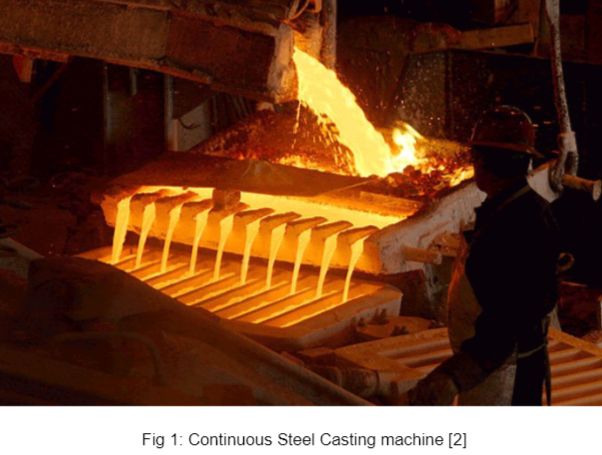Choose a different country or region to see the content specific to your location
Select Your Country/Region
Current Region:
 Global (EN)
Global (EN)
How can we help you?

During the early 1900’s the steelmaking industry suffered from poor quality of the final product. This was mainly attributed to the presence of hydrogen and nitrogen in the molten steel. The presence of hydrogen resulted in pinholes and porosity of the final product. The low solubility of hydrogen in steel at ambient temperatures resulted in its release during solidification thereby reducing the yield strength. Similarly, nitrogen also had low solubility in steel which resulted in defects like embrittlement and reduced ductility. These effects laid the foundation of vacuum degassing processing in the steel making industry.
The idea of using a vacuum to remove dissolved gases from molten steel was initially proposed in 1940 by Soviet scientists A. M. Samarin and L.M. Novik. It was first tried industrially in 1952 at the Enakievskii metallurgical plant in the Soviet Union and in 1954 in Germany. By 1960, more efficient vacuum degassing methods such as the Dortmund Hoerder (DH) and Ruhrstahl-Heraeus (RH) methods became popular. They were followed in the mid-1960s by additional processes such as vacuum arc degassing, the ASEA-SKF process, and the vacuum oxygen decarburization process for high chromium steels. Soon after, this technology became an essential part of the steelmaking process and is now used throughout the world [1,2].

Vacuum degassing systems employ different methods to maximize the surface area of molten steel. Two methods of vacuum degassing: ladle degassing and stream degassing are discussed here.
The recent development in ladle steel making by using vacuum arc degassing (VAD), is gaining prominence throughout the world and offers many technical advantages in the melting of high-quality steels. This process is one in which the refining operation, normally carried out in the second stage of the two-slag basic electric arc process, is done in the ladle, and more effectively. Furthermore, the steel is degassed in the same ladle as part of the VAD process.
There are both economic and metallurgical advantages to be gained from the process. The major economic saving is in the reduction of tap-to-tap times since, both the refining and degassing are being done simultaneously in the VAD vessel, a further charge may be melted out in the arc furnace in readiness for subsequent transfer to the VAD unit. The major metallurgical advantages relate to quality and stemming from the high degree of control built into the VAD system [3].

The teaming of forging ingots and ladle-to-ladle degassing take place in a tank which is closed with a vacuum-tight cover. The cover is skewed hydraulically across the tank or is suspended from a cover car and driven over the tank and then lowered. Each cover is equipped for locating the tapping ladle on to a grooved ring made air-tight by the insertion of a Neoprene seal. The ingot or ladle size dictates the dimensions of the vacuum tank. The vacuum tightness between tank and cover is achieved with a sealing ring contained in an open channel. During opening of the cover, the seal is protected from radiation by flooding the channel with water. Both tank and cover flange are water cooled to prevent distortion. The opening for the pouring of the steel is initially covered with a metal membrane so as to allow the evacuation of the tank before teeming. A spray limiter tube is suspended from the cover so as to ensure that the stream is directed into the evacuated tank as intended after melting of the membrane. The diameter and length of the spray limiter tube are calculated to allow the steel to fan out with most of the degassing taking place before the stream exits from the tube. Splashing against the ingot wall or ladle lining is thus prevented. The spray limiter tubes for vacuum-cast forging ingot production consist of special refractory bricks and can be used several times. While those for ladle-to-ladle degassing are made from ceramic material and have an excellent refractory performance with intermediate patching if necessary.
The vacuum tank is refractory lined with firebrick mainly against radiation and possible ladle break-through. Normally, the tank height is such that in case of a ladle break through, the liquid steel content can be contained in the bottom of the tank without affecting the ladle. This makes it possible to remove the empty ladle without difficulties. In the same way the solidified steel can be lifted out by crane. Generally, an ingot mould is used as a ladle stool, which assists in the removal of the cold steel. The underside of the cover is protected by a refractory layer against radiation and splash.
Observation ports in the cover serve to follow the degassing treatment. Local control panels are placed on the cover and are fitted with control valves and instrumentation. Deoxidation and alloying trimming additions can be made during ladle-to-ladle degassing via a vacuum lock. Chemical consistency throughout the melt is one of the results of inert gas stirring.

For the production of low-carbon high-chromium steels, the vacuum ladle degassing station is an ideal facility. An oxidizing variant of this process has been developed, known as the vacuum oxygen decarburizing [VOD] process. In this treatment, not only is the oxygen already dissolved in the melt continually supplemented through the addition of solid oxygen carriers, but gaseous, pure oxygen is also blown onto the melt from above through a lance in order to achieve higher decarburization rates. The VOD process offers the advantages that the decarburization reaction is considerably stronger under low pressure conditions than other oxidizing reactions. This thermodynamic law is of particular interest in the production of very low carbon high-chromium steels.
A modem VOD facility for melt weights of 15 to 90 t comprises the following equipment (Fig 4).
Under vacuum has been the subject of numerous investigations. If there are no strong nitride formers in the melt, the nitrogen content can be reduced to 20 ppm without difficulty. In cases where nitride-forming elements are present in the melt, such as Cr, Va, A1, and Ti, the activity of the nitrogen is appreciably lowered, with the result that nitrogen removal under high vacuum is more difficult. In order to be able to still obtain alloys with low nitrogen contents, low-nitrogen raw materials must be used. Too high a nitrogen content in the Ni-based alloys can lead to microporosity resulting during precision {investment} casting. Production results obtained during melting under vacuum indicates that the nitrogen content is reduced to 50 ppm from an average of 400ppm at the beginning of the treatment. Melting takes place in the open induction furnace which, in contrast to the electric furnace produces substantially higher nitrogen contents. There is still no clear proof that additional argon bubbling has a reducing effect on the nitrogen contents of steel on the other hand, in the cast of Ni-Fe alloys, the influence of argon bubbling as compared with conventional proactive is clearly identifiable with nitrogen contents of up to 50% lower being achieved.
The theoretical equilibria and metallurgical results in this connection have been thoroughly investigated. Hydrogen removal during the degassing treatment here amounts to approximately 85%. Argon bubbling appears to have had no identifiable effect. The inductive bath swirl is fully adequate in the case of this furnace operated at mains frequency.
There are three types of pumping systems used in vacuum degassing: (a) steam ejectors with necessary condensation stages; (b) steam ejectors in combination with water ring pumps; and (c) dry screw pumps, which don’t require a steam ejector.
All the vacuum pumps need to fulfill the following tasks: Quick pump down, Controlled pump down, maintaning a volumetric flow and reach a low pressure [5].
Table 1: System Design consisting of Roots blower and Dry Vacuum Pumps [4]
| VD Melt size [t] | Typical VD mass flow rate [kg/hr] | Effective pumping speed @0.67 mbar [m³/hr] | No of modules | Typical system configuration | ||
|---|---|---|---|---|---|---|
| No. WH 3rd stage | No. WH 3rd stage | No. DV 1st stage | ||||
| Example for smaller melts with one system module: | ||||||
| 30 | 30 | 37,600 | 1 | 5 | 2 | 2 |
| 35 | 35 | 43,900 | 1 | 6 | 2 | 2 |
| 40 | 40 | 50,100 | 1 | 7 | 2 | 2 |
| 45 | 45 | 56,400 | 1 | 8 | 2 | 2 |
| Example for bigger melts with parallel system modules: | ||||||
| 75 | 75 | 94,000 | 2 | 7 | 2 | 2 |
| 100 | 100 | 125,300 | 3 | 6 | 2 | 2 |
| 130 | 130 | 163,000 | 3 | 8 | 2 | 2 |
Table 1 presents the variation of VD mass flow rate and effective pumping speed with increase in melt size. The effective pumping speed shows a significant rise with increase in melt size. Table 2 presents a cost benefit analysis where Dry Mechanical vacuum system results in significant annual savings compared to steam ejector vacuum system [4]. Use of the Dry Mechanical system results in major annual savings. The more number of components will result in higher exergy loss in the MVP system. However, with proper optimization and development of efficient subsystems, these losses can be minimized.
Table 2: Steam Ejector vs Dry Mechanical cost comparison [4]
| Degasser type: 45t VD, 8-2-2 system configuration Heats: 10 heats/day Utilization: 300 days/year Annual production: 135,000 t |
||
|---|---|---|
| Type of Vacuum System: | Steam Ejector | Dry Mechanical |
| Expenses: | ||
| Energy and Fluids | 255,000 ₠ | 4,800 ₠ |
| Maintenance and Spares | 54,700 ₠ | 8,100 ₠ |
| Total costs per year: | 309,700 ₠ | 12,900 ₠ |
| Annual Saving | 296,800 ₠ ⩠2.20 ₠/t |
|


Vacuum Degassing plays an important role in manufacturing high quality steel. The choice between SVP and MVP is based on several aspects like energy and fluid consumption, wear, maintenance and cleaning, redundancy, availability, emissions, dust and sludge handling climatic conditions, safety and health standards. A dry MVP system offers quick response time to gas load changes, pressure control, redundancy, compliance with ATEX requirements, rapid exchangeability of individual pumps and upgrading possibility [5].
Everest Vacuum has been providing Technical and R&D solutions for various process industries over the last 15 years. We have provided customized vacuum systems to many reputed organizations in India and overseas. We believe in empowering our customers with the best possible customized vacuum system for eco-friendly overall development.

Dr V Ravindra is a Mechanical Engineer who has done his PhD from Indian Institute of Technology, Kharagpur. He is working as R&D Manager at Everest Vacuum and he is involved in designing modern vacuum systems for process applications based on customer requirements. He is also developing training modules related to Vacuum Technology and process applications.